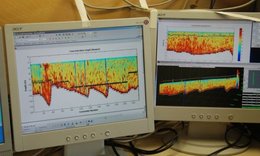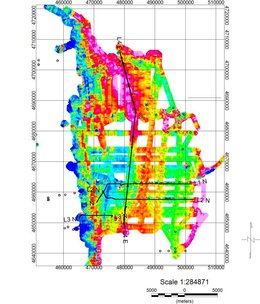Die Inhalte dieser Seite sind leider nicht auf Deutsch verfügbar.
Seitenpfad:
SD1 PhD projects
Cohesive sediment transport in complex coastal environments
The intermittent nature of suspended transport is commonly associated with the occurrence of coherent flow structures generated in the bottom boundary layer. Coherent Flow Structures are irregular, but repetitive turbulent events believed to be caused by the deformation and evolution of vortices in the seabed region. They are characterised by rapid in- and outrush of fluid from the near-bed region, interspersed with quiescent inter-event periods.
High frequency hydro-acoustic and optical sensors have been deployed to derive time series of velocity fluctuations and suspended sediment concentration throughout the water column over several tidal cycles. This will enable the determination of inter-event period of the flow structures and suspension events close to the seabed and possibly scaling to dune or flow variables. Furthermore, it is aimed at a better understanding of the processes causing the confined upward transport of material and sustainment of the clouds at the water surface.
High frequency hydro-acoustic and optical sensors have been deployed to derive time series of velocity fluctuations and suspended sediment concentration throughout the water column over several tidal cycles. This will enable the determination of inter-event period of the flow structures and suspension events close to the seabed and possibly scaling to dune or flow variables. Furthermore, it is aimed at a better understanding of the processes causing the confined upward transport of material and sustainment of the clouds at the water surface.

Electromagnetic Imaging of the marine subsurface: A novel approach to assess sediment patterns and dynamics on clastic shelf systems
Clastic shelf systems, as major sediment sources and sinks, build the critical interface between the continent and the ocean on the sediment pathway. Surficial sediments in these areas are subjected to high dynamic processes driven by climatic, hydrodynamic or anthropogenic influences and therefore provide information about the recent and paleo environmental situation.
Classical sedimentological investigations based on surface sampling and sediment coring often do not provide sufficiently high spatial resolution. A novel approach to overcome this limitation is the electromagnetic (EM) imaging of the marine subsurface. The EM data provides information about the magnetic susceptibility and electric conductivity of the bottom sediments in sub-meter resolution. Magnetic susceptibility offer valuable clues to the mineral composition of the sediments and can particularly be used as a proxy for fine-grained terrigenous clay/silt content, diagenetically forced magnetite depletion, anthropogenic metallic contaminants and metal accumulation. Electric conductivity is mainly controlled by the pore fluid and is therefore primarily considered as a measure of porosity and grain-size distribution. The results obtained from the EM measurements can be merged and jointly interpreted with other high-resolution geophysical and oceanographic data sets, such as derived from acoustic backscatter, conductivity-temperature-depth (CTD) and turbidity measurements, and calibrated with laboratory data from surface samples.
Classical sedimentological investigations based on surface sampling and sediment coring often do not provide sufficiently high spatial resolution. A novel approach to overcome this limitation is the electromagnetic (EM) imaging of the marine subsurface. The EM data provides information about the magnetic susceptibility and electric conductivity of the bottom sediments in sub-meter resolution. Magnetic susceptibility offer valuable clues to the mineral composition of the sediments and can particularly be used as a proxy for fine-grained terrigenous clay/silt content, diagenetically forced magnetite depletion, anthropogenic metallic contaminants and metal accumulation. Electric conductivity is mainly controlled by the pore fluid and is therefore primarily considered as a measure of porosity and grain-size distribution. The results obtained from the EM measurements can be merged and jointly interpreted with other high-resolution geophysical and oceanographic data sets, such as derived from acoustic backscatter, conductivity-temperature-depth (CTD) and turbidity measurements, and calibrated with laboratory data from surface samples.



